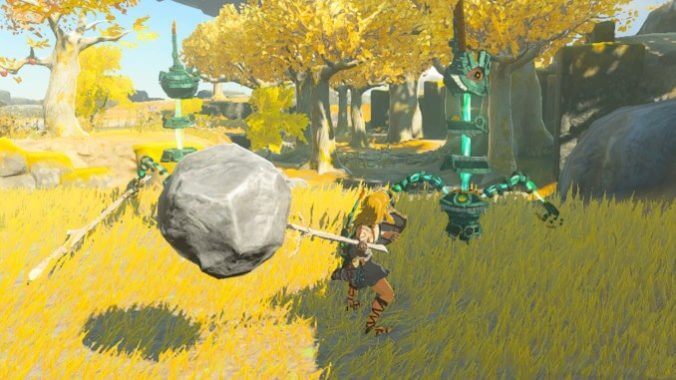If you somehow missed the news that weapon degradation would return in The Legend of Zelda: Tears of the Kingdom, don’t worry: the game lets you know definitively in its very first real fight. Or at least it did for me, when not one, but two weapons broke during my first faceoff with a Soldier Construct, mere minutes into the game.
One of those weapons broke purely for storyline reasons. When Tears starts, Link is fully powered up, with two rows of hearts and one of the strongest weapons in the game. (It’s the Master Sword. Maybe you’ve heard of it.) He’ll use it to swat down some bats during a tutorial fight that exists solely to tell you how to use your weapon. He gets stripped of that massive reservoir of health very quickly, getting depowered like Samus in a Metroid game, and his sword becomes corrupted, By this point he’s made it to the game’s first real section, high up in the Sky Islands, where he quickly encounters one of the ancient Soldier Constructs that still protect these ruins. That corrupted sword breaks apart the first time he uses it on an enemy, letting players know that weapons don’t last long in this game.
That’s fine. That’s well and good. It’s instructional. The only other weapon I had found up to that point was a tree branch, and as a Breath of the Wild veteran I knew to cycle to that as soon as my sword went kaput. And although I knew a tree branch wouldn’t cut it for that long, I figured it would probably get me through this first skirmish. Instead, it, too, fell apart after only two or three whacks. I had to scramble around this floating island to find anything else I could use against the ancient robot, which wound up being another tree branch. Fortunately this one was enough to finish the job, and I was able to grab the Construct’s stronger, more resilient weapon to use in the next fight.
I don’t know if this happens to every Tears of the Kingdom player. Perhaps there was a stronger weapon than that tree branch that I passed by without realizing it. Maybe you don’t immediately have to fight that specific enemy; even though it’s a glorified tutorial, that first section of Tears offers the same freedom to explore and experiment that the series has always been known for, and maybe I beelined to that construct a little too hastily. All I know is I expected the Master Sword to not make it through my first fight, but I didn’t expect two weapons to bust up back to back like that.
If you never played Breath of the Wild, and Tears is your first experience with its short-lived weapons, this opening section should prep you for how annoying it can be. I appreciate what Nintendo is going for with it, and enjoy the unpredictability it brings to combat, but it’s easily the most controversial aspect of this current Zelda series. It’s as prominent in Tears as it was in Breath, so if you have a problem with that just know what you’re getting into. Your stuff’s gonna break constantly, and all you can do about it is whip out something new to fight with before whatever monster you’re scuffling with takes advantage.
Tears does innovate how its weapons work in one major way. With the Fuse skill you can graft rocks, plants, and even body parts from defeated monsters onto your weapons, usually increasing their damage and sometimes giving them a special ability. With the right addition, a sword can shoot fire, freeze enemies, or do all kinds of wacky jive. This makes weapon degradation less punitive than it felt in Breath. If you’re suddenly left with nothing but a tree branch, a rusty knife, or another piddling weapon like that, you can immediately make them more formidable by slapping a monster’s horn or tail on them. This helps offset the inconvenience of losing your best weapon in the middle of a fight, but doesn’t do away with it—so if you did hate that aspect of Breath of the Wild, you might still hate it here, but perhaps that extra spot of flexibility will ease your mind a bit.
I get why people think it’s obnoxious to have their weapons fall apart constantly. It really is inconvenient, and weapons almost always break much earlier than you can expect them to. Sometimes you get on an unlucky streak where all of the game’s more annoying parts hit at once—you’re trying to climb but it starts to rain and you can’t get a grip, it’s a lightning storm so you have to unequip all of your metal weapons and armor, you come across some monsters and the wooden club or pole you’re fighting with breaks almost immediately, and then, as soon as you beat them, a Blood Moon rises and they all come right back to life. That actually happened to me last night. These aren’t random decisions by the game’s designers, though, or attempts to punish players, or even just the kind of details that can make a game world feel more realistic and immersive. The way Breath of the Wild and now Tears of the Kingdom are designed basically necessitates all of these choices, to keep players from becoming too powerful too early and waltzing God-like to the game’s conclusion. That’s most apparent with how it handles its weapons, and if you’ve got a problem with that, you’ll probably have a problem with Tears of the Kingdom.
Senior editor Garrett Martin writes about videogames, comedy, travel, theme parks, wrestling, and anything else that gets in his way. He’s also on Twitter @grmartin.
